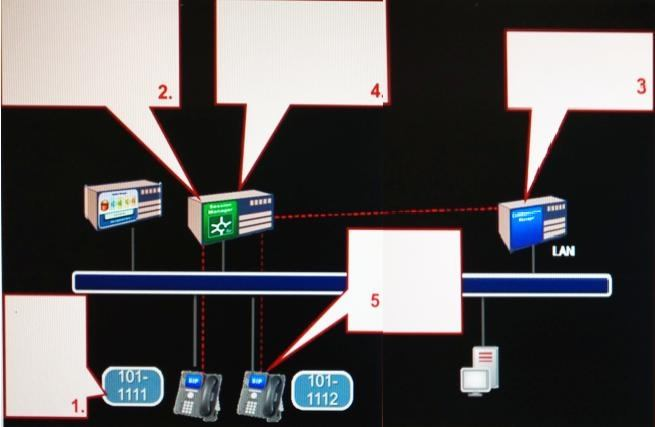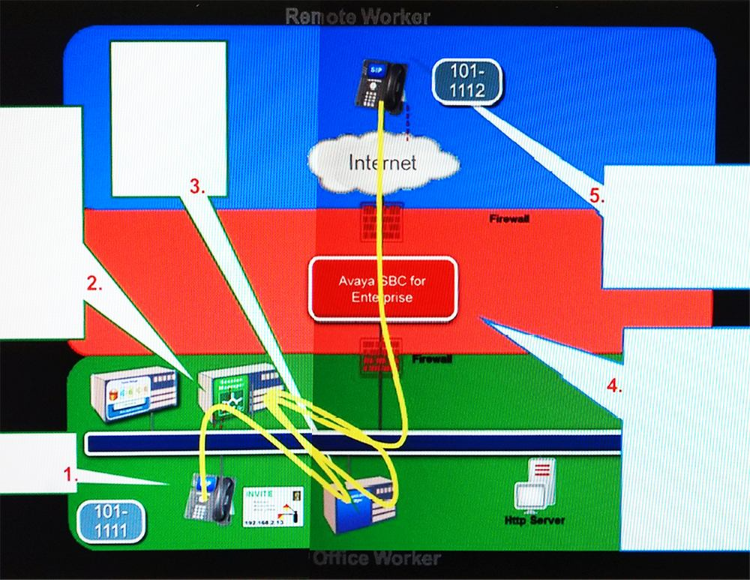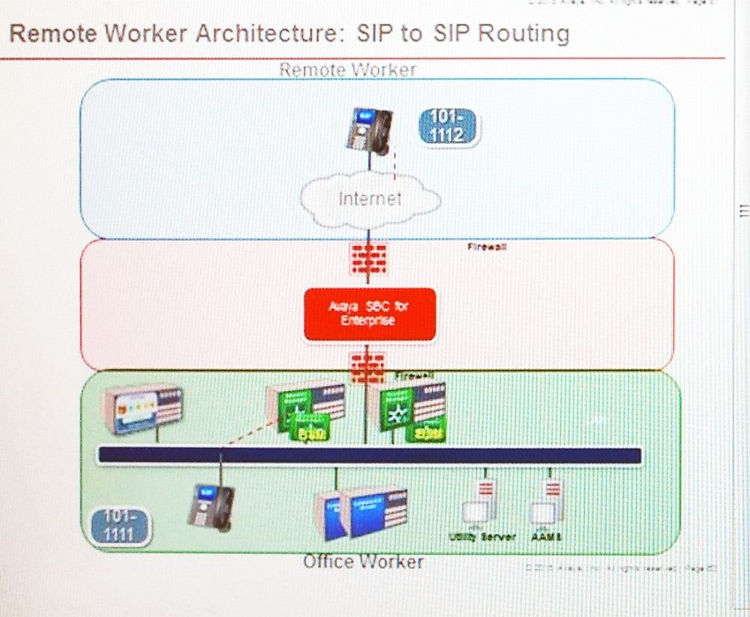Download Avaya Aura Core Components Support Exam.7220X.PracticeTest.2017-12-22.66q.vcex
| Vendor: | Avaya |
| Exam Code: | 7220X |
| Exam Name: | Avaya Aura Core Components Support Exam |
| Date: | Dec 22, 2017 |
| File Size: | 3 MB |
How to open VCEX files?
Files with VCEX extension can be opened by ProfExam Simulator.
Discount: 20%
Demo Questions
Question 1
Refer to the Exhibit.

Which two statements are true about a call from AST 1011111 to AST 1011112? (Choose two.)
- In step 3, Avaya Aura® Communication Manager (CM) sends SIP Options to 1011112 looking for a 200 ok response to check it is reachable.
- In step 2, Avaya Aura® Session Manager (SM) matches 1011111 with a Communication Profile, and uses the defined Originating Application Sequence to route the call to Avaya Aura ® Communication Manager.
- In step 1, when 1011111 draws dial tone it sends an Invite to Avaya Aura® Session Manager (SM) with the Request URI containing 1011111.
- In step 2, the Avaya Aura® Session Manager (SM) uses a dial pattern and routing policy to route the call to Avaya Aura® Communication Manager (CM).
Correct answer: BC
Question 2
What statement about the H.323 to SIP routing is true?
- Avaya Aura® Communication Manager does feature processing for both endpoints.
- Avaya Aura® Communication Manager does feature processing for H.323 endpoint only.
- Avaya Aura® Communication Manager does feature processing for SIP endpoint only.
- Avaya Aura® Communication Manager does not do feature processing for any endpoint in this scenario.
Correct answer: A
Question 3
Refer to the Exhibit.

A SIP user is calling an H.323 user.
In this call flow, in which phase does Avaya Aura® Communication Manager (CM) handle the call processing foe each endpoint?
- both endpoints in the originating phase
- H.323 endpoint in originating phase, SIP endpoint in terminating phase
- SIP endpoint on originating phase, H.323 endpoint in terminating phase
- both endpoints in the terminating phase
Correct answer: C
Question 4
When retrieving a message from Avaya Aura® Messenger (AAM), what is the function of the RE-INVITE?
- The RE-INVITE is only used when the initial INVITE is not transmitted successfully.
- The RE-INVITE shuffles the media path off Avaya Aura® Communication Manager (CM).
- The RE-INVITE is to allow the user to be authenticated.
- The RE-INVITE is only sent if a voice port cannot be initially connected to the caller.
Correct answer: C
Question 5
Refer to the Exhibit.

Which two statements about a call from AST 1011111 to Remote Worker AST 1011112 are true? (Choose two.)
- Avaya Session Border Controller for Enterprise (SBCE) periodically sends SIP Options to 1011112 looking for a 200 ok response to check it is reachable.
- SIP Signaling traverses the Avaya Session Border Controller for Enterprise (SBCE) and the Media must bypass the SBCE.
- As far as Avaya Aura® Session Manager (SM) is concerned, all Remote Worker phones are registering from an IP address equal to the Avaya Session Border Controller for Enterprise (SBCE) Remote Worker Private IP address.
- Avaya Session Border Controller for Enterprise (SBCE) needs to be built as a trusted SIP Entity and Entity link for remote workers.
- The configuration of a Remote Worker AST is the same as an Office Worker AST in the Avaya Aura® System Manager (SMGR) user profiles.
Correct answer: CE
Question 6
Refer to the Exhibits.


The SIP call flow made from an Avaya Communicator Remote Worker is on the left, and the call flow made from a 96X1 telephone Remote Worker is on the right.
When comparing the two call flows, which statement is true?
- There is no difference between the two.
- Avaya Aura® Communication Manager does full call model processing for the SIP-to-SIP call flow and does half-call model processing for the SIP-to-Communicator call flow.
- The Communicator does not register to Avaya Aura® Session Manager.
- The Communicator registers to Avaya Session Border Controller for Enterprise (SBCE).
Correct answer: A
Question 7
After an Avaya Aura® Communication Manager (CM) upgrade, a customer called Avaya support because their SIP telephones were unable to login. Support was able to confirm that the telephones had not been upgraded.
Which pre-implementation step was omitted?
- Provide accurate licensing specification.
- Verify version installed is compatible with existing versions.
- Test all third-party equipment and software.
- Access support.avaya.com to verify customer systems compatibility.
Correct answer: B
Question 8
Which two statements regarding the core architecture in the Avaya Aura® 7 solution are true? (Choose two.)
- SIP trunks can only be configured on Avaya Aura® Session Manager (SM).
- SIP user Agents register with Avaya Aura® Session Manager (SM).
- SIP User Agents can register to Avaya Aura® Communication Manager (CM) or Avaya Aura® Session Manager (SM).
- Avaya Aura® Media Server (AAMS) cannot connect to Avaya Aura® Communication Manager (CM) without routing via Avaya Aura® Session Manager (SM).
- Avaya Aura® Media Server (AAMS) connects directly to Avaya Aura® Communication Manager (CM) using SIP.
Correct answer: BE
Question 9
Which statement about Interfaces and IP addresses on an Avaya Session Border Controller for Enterprise (SBCE) used for SIP-Trunking and Remote Worker services is true?
- SIP Trunking and Remote Worker services can use different IP addresses configured on the same Interface.
- SIP-Trunking and Remote Worker services can share the same IP address.
- Only one IP-address should be configured per interface.
- SIP-Trunking and Remote Worker services cannot run on the same SBCE.
Correct answer: A
Question 10
A remote worker using the Avaya Communicator on the smart mobile phone obtains a private IP address delivered from the corporate network over WiFi when in range of the wireless hotspot. When the remote worker is out of range of the corporate WiFi it obtains a Public IP address via the 3G/4G mobile Service Provider.
When roaming from the public network to the corporate private network and vice versa, which strategy prevents the user from having to change the SIP Proxy Server address in the smartphone?
- Network Address Translation (NAT)
- Avaya Session Border Controller for Enterprise (SBCE) public IP-address
- Split Horizon DNS with FQDN
- Virtual Private Network (VPN)
Correct answer: C
HOW TO OPEN VCE FILES
Use VCE Exam Simulator to open VCE files

HOW TO OPEN VCEX AND EXAM FILES
Use ProfExam Simulator to open VCEX and EXAM files


ProfExam at a 20% markdown
You have the opportunity to purchase ProfExam at a 20% reduced price
Get Now!



